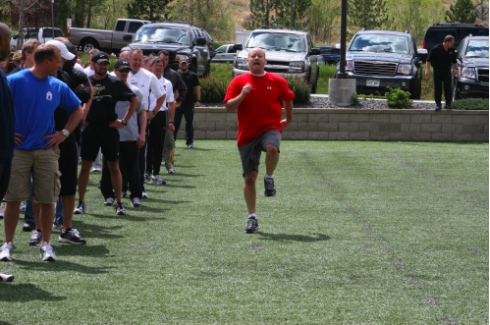By: Morgan Urtso
 Paul Theodore recently attempted to break the world record for the most pull-ups in 24 hours (4,025 set in January by David Goggins). While Theodore didn’t rewrite the record books, he locked in
Paul Theodore recently attempted to break the world record for the most pull-ups in 24 hours (4,025 set in January by David Goggins). While Theodore didn’t rewrite the record books, he locked in
2,501 pull-ups
in 15 and a half hours.
Theodore showed the world he’s a contender. ATLX pulsed Theodore for his training routine in our All About the Madness feature, Pull-Ups for a Purpose, Chasing a World Record. Theodore, a fitness trainer himself, worked for 12 weeks straight in preparation for his pull-up project.
Applying the same concepts he used while training for marathons, Theodore progressed gradually with three goal-specific workouts per week: one short, one medium, and one long session. Increasing his reps and endurance each week resulted in steady, lasting progress. Theodore noted that his training regime was much simpler than one would think.
Here’s the breakdown:
SESSION 1: STRENGTH
10 sets of 5-10 reps with a 40lb vest. Rest 5 minutes in between each set.
SESSION 2: 5 SETS OF 15-25 REPS
Rest 3-5 minutes between sets, typically mixed in with a total body workout routine.
SESSION 3: ENDURANCE
6-8 reps on the minute or every other minute, for 1-4 hours continuously.
“Variety is key,” Theodore added. “Mixing up the grip from regular pull-up position to deadlift grip, gorilla grip, chin-up grip, etc. helps to hit all different muscle groups.”
Nutrition:
As a fitness trainer, Theodore generally maintains a very healthy diet on a regular basis, but he carb-loaded before he battled the bar to maximize energy potential. He also added three new supplements to his daily intake:
ARGININE
An amino acid that promotes the production of nitric oxide, which helps support blood circulation and muscle growth. Arginine is also used to maintain heart health and is associated with protein metabolism.
BCAAs
Branched chain amino acids serve as a muscular energy source and building block for muscle tissue. They enhance fat oxidation in glycogen depleted subjects, increasing physical performance and endurance.
GLUTAMINE
An amino acid that increases cell hydration and protein synthesis, promoting muscle growth. It improves recovery and may defer muscle fatigue.
How to increase your pull-ups:
Even Theodore, a master of the craft, admits the pull-up is the most challenging exercise in fitness. “But it is also the ultimate strength building exercise that everyone can and should do,” he urged. “It just might take some time to build up.”
As a trainer, Theodore is a seasoned veteran in helping clients lock down that highly coveted perfect pull-up. “I usually use a four-step progression to get someone from no pull-ups to pull-ups,” he said. “There is really no way to replicate the movement with any machine or weights, so you have to get yourself training with your bodyweight.”
1. Start with hanging. Just get your body used to hanging from the bar for thirty to sixty seconds.
2. Use resistance bands or the assisted pull-up machine to help decrease the weight you’re pulling up. Start with a weight that you can do 10-12 reps with full range of motion, extended at the bottom and chin to the bar. Decrease the assistance each week until you’re able to do without.
3. Practice chin-ups. Chin-ups are easier than pull-ups. Work on increasing them to develop more strength in your arms and back.
4. Finally, you’re on to pull-ups. A great way to increase your strength is to use “negatives.” This is when you focus on the eccentric motion, or the down motion of a pull-up. Jump to get your chin to the bar and then fight in a controlled manner for three to five seconds on the way down. Just remember to squeeze your shoulder blades back at the top and keep the tension on them and your arms on the way down. Then jump up again and repeat for 8-10 reps.
Want more ATLX exclusives? Follow us on Twitter and like us on Facebook.
 ATLX The only sports entertainment television and digital media network fully devoted to everyday athletes, athletic lifestyle and athletic culture.
ATLX The only sports entertainment television and digital media network fully devoted to everyday athletes, athletic lifestyle and athletic culture.




